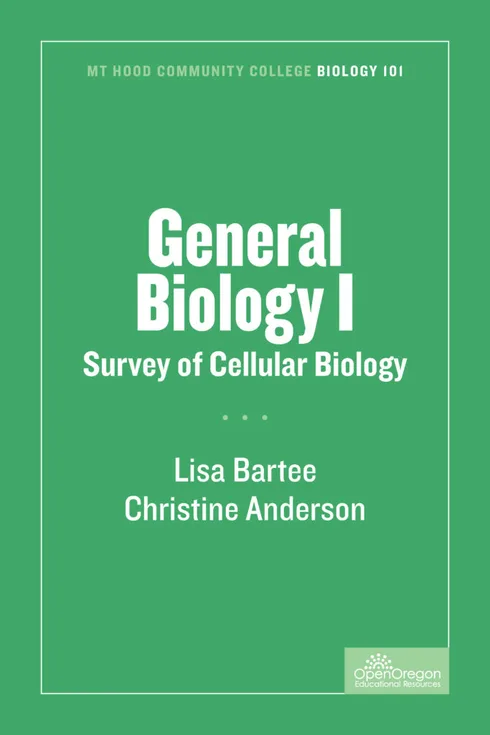
General Biology I: Survey of Cellular Biology
![]()
![]()
![]()
![]()
![]()
Lisa Bartee, Mt Hood Community College
Christine Anderson, Mt Hood Community College
Copyright Year:
ISBN 13: 9781636350431
Publisher: Open Oregon Educational Resources
Language: English
Formats Available
Conditions of Use
![]() Attribution
Attribution
CC BY
Reviews
Reviewed by Lynette Hauser, Professor of Biology, Tidewater Community College on 7/22/22
The text covers the material well and at an introductory level. The text does not include a glossary. There are learning objectives outlined at the start of each chapter as well as interactive practice questions for students to test their... read more
![]()
![]()
![]()
![]()
![]()
Reviewed by Lynette Hauser, Professor of Biology, Tidewater Community College on 7/22/22
Comprehensiveness
The text covers the material well and at an introductory level. The text does not include a glossary. There are learning objectives outlined at the start of each chapter as well as interactive practice questions for students to test their knowledge. I was surprised the book did not include information about chemistry or organic compounds. These ideas, at least on a basic level, seem essential to understand cell function, membrane transport, etc. There were also processes that could have added graphics, like facilitated diffusion and active transport.
Content Accuracy
I did not find an errors or biased in the text. The information is accurate.
Relevance/Longevity
As the textbook is written in very short sections it appears it would be easy to extract one section, update, and re-insert. The examples are relevant but don't appear to be dated.
Clarity
Appropriate tone for an introductory textbook. Harder terms are defined/explained clearly and more complex ideas are simplified when possible.
Consistency
The text is consistent in the presentation of ideas and concepts. The flow of the chapters is identical. Terminology is displayed consistently in bolded terms. Graphic text is also consistent, and citations are consistent.
Modularity
The text has 56 different chapters each of which is a few pages in length. This does support the easily readable and divisible text objective of modularity but I thought there were too many divisions. It makes more sense to me to have few chapters with subsections, and that the subsections would renumber in each chapter, so chapter one, section 1.1, 1.2, 1.3 and then Chapter two, 2.1, 2.2, 2.3, etc. I think Part 8 chapter 53 is more confusing as a reader.
Organization/Structure/Flow
Overall the order/organization of the topics makes sense and is clear and logical. I personally do not teach about phylogenetic trees until later in the semester and this text included it in one of the first sections as part of characteristics of life.
Interface
When I downloaded the book as a PDF the interactive questions no longer functioned. However, there were links I could click on to take me to the web version of the text to use the practice questions. I experienced no navigation issues with the website or PDF version. The PDF text did have one very distorted image of the levels or organization that was challenging to read, it was blurry. Other images in the PDF text were clear.
Grammatical Errors
I did not find any grammatical errors.
Cultural Relevance
The book is not culturally insensitive or offensive.
Table of Contents
- I. 1. Reference Information
- II. The Process of Science
- III. Themes and Concepts of Biology
- IV. Cell Structure and Function
- V. Membranes and movement of molecules
- VI. Enzyme-catalyzed reactions
- VII. How cells obtain energy
- VIII. Photosynthesis
About the Book
BI101: Survey of Cellular Biology is intended for one term of the introductory biology course for non-science majors taught at many two- and four-year colleges. The concepts of cellular biology, as they apply to the study of life, are introduced, including parts of a cell, metabolism, and homeostasis.
This textbook incorporates the mandates found in Vision and Change and focuses on the non-content aspects of biology education that are just as important. Additionally, this book explicitly teaches the general education outcomes that we have identified as important for this class. This textbook pulls together biology content resources that are accessible for our community college non-major biology students, as well as resources to provide them with explicit instruction in the quantitative literacy, communication, and information literacy general education outcomes as they relate to the biology content they are learning.
Contact the author for inquiries about quiz
About the Contributors
Authors
Lisa Bartee, Mt Hood Community College
Christine Anderson, Mt Hood Community College
Ancillaries
Quizzes
- Open Oregon Educational Resources (by request)
